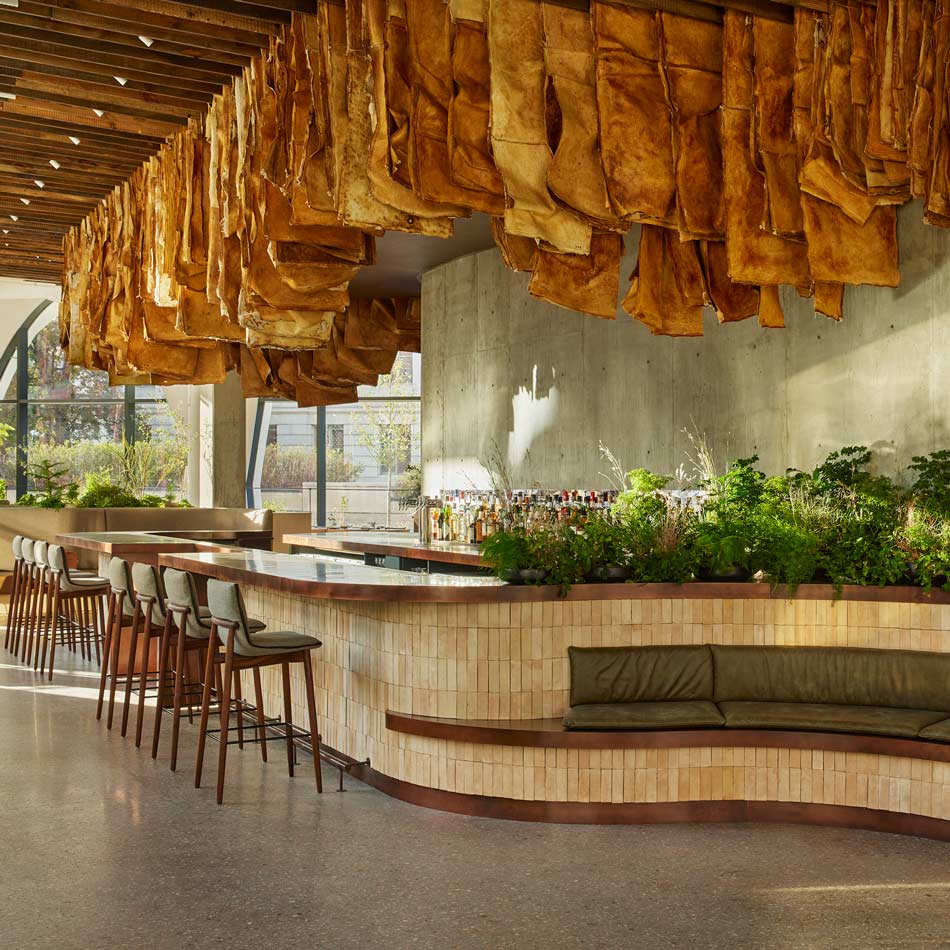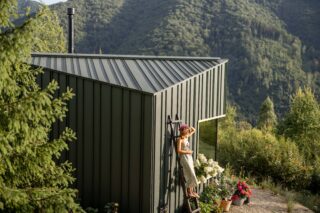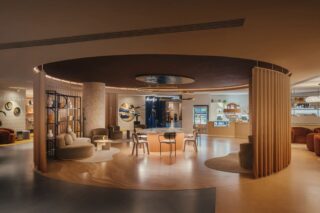Going gaga over fungi, we spoke to the founders of MycoWorks about its new “it-product” for furniture manufacturing: Reishi™.
You could be forgiven for thinking that the smooth shimmering sheets of warm-hued gold and brown material hanging at an exhibit near the entrance of The International Contemporary Furniture Fair in New York City this past May were leather or perhaps some new-fangled form of pleather due to their lack of imperfections on their surface. Displayed in pebble, natural and, Doux textures, the robust sheets were tough and pliable. You could fold them, and they would spring back without a crease. However, don’t be fooled, they were in fact a fungi-based material called Reishi™ developed by biotech firm MycoWorks, which may be on the verge of becoming the new “It-product” in furniture and fashion.
For some time now, the design world has been going gaga over fungi, also known as mycelium, which is touted a more environmentally sustainable material for clothing and furniture than plant or animal-based products. Although the relatively new biomaterial has received a fair amount of attention in design schools, arty exhibits, and international exhibitions such as the Venice Architecture Biennale, it has until recently been a niche product.
During ICFF, MycoWorks demonstrated its flagship biomaterial made from mycelium (the root structure of mushrooms): Reishi ™. It recently surpassed traditional luxury materials’ quality benchmarks: Bally Flex resistance (flexibility, creasing), Martindale Abrasion Resistance, Colorfastness (dye transfer), Ageing Test, Finish Adhesion. At ICFF, the firm displayed pieces from the Mycelium Muse collection and its partnership with Studio TOOJ.
Mycelium-based Product Design Evolves
Indeed, for many years mycelium was more typically found in artworks such as the sculptures produced by Phil Ross, a San Francisco Bay-based American sculptor who has been working with fungi for more than thirty years and used the knowledge he gained in his art career to found MycoWorks together with Sophia Wang in 2013.
Now, thanks to new recent refinements in its manufacture, which is dependent on more than 80 patents and allows it to be produced in sheets as thin as .04 millimeters, Reishi™ has become a luxury material and in industry tests has surpassed furniture benchmarks that measure crease-resistance, colorfastness, and abrasion resistance.
Designers such as Yume Yume, Hermes, and Ligne Rosset, have been using Reishi™ in batch amounts for lines of products ranging from handbags to sofa coverings. It is also showing up in new high-end sustainable buildings where it has been used for drapes and upholstered wood panels. Hundreds of sheets of the biomaterial were used for decorative touches in the Populus Hotel in Denver, Colorado, which opened in 2024 and claims to be the first carbon-positive hotel in the United States, meaning that it will sequester more carbon than it emits.
Above: Ligne Roset Introduces Sofa Made with Reishi Fine Mycelium by MycoWorks
Right: Interior design of the restaurant at the Populus Hotel. Photo credit: Yoshihiro Makino.
The Populus Hotel blends nature-inspired design with environmentally conscious hospitality to put the health of the planet first. Pioneering its flagship mycelium-made biomaterial, Reishi™ in interior design, Denver’s Populus used nearly 500 sheets in, “The Reishi Tapestry,” an eye-catching sculpture that hangs above the hotel’s ground floor restaurant, Pasque.

WATCH a video about the Populus Hotel here.
First Large-scale Mycelium Factory in the US
Now the biomaterial is becoming available to the general consumer. A new MycoWorks factory in Union South Carolina that opened in 2023, purportedly the first large-scale mycelium factory, is producing millions of square feet of Reishi™ and there also is a new e-commerce site.
“It’s one of the biggest regenerators on the planet,” declares Fredrick Martel, Vice President of sales for MycoWorks, adding that “Reishi is 10X lower in terms of carbon emissions than leather.”
One of the big advantages of Reishi, Martel explains is that it is almost completely non-toxic in its manufacture and not dependent on resource-consuming agriculture or extractive industries such as petroleum-based plastics. It typically takes 4 weeks to grow and harvest a sheet of mycelium which is fed solely with sawdust, a waste material, and a spritz of water. Afterwards, the material is peeled off the wood and sent to a tannery where it is dyed and embossed with different textures.
Set to Disrupt the Design World
As it is not an animal product, when Reishi is tanned it doesn’t require polluting chemicals such as chromium, which is necessary to fix the collagen in leather so that it doesn’t smell and degrade. In addition, Martel says there is a huge cutting efficiency compared to animal hides where there can be between 40-60 percent waste because of the innate inconsistencies in thickness and texture.
It does appear that this fungi-based miracle material has the potential to completely disrupt the design world and replace leather, cotton, and synthetics in many products. It doesn’t have the innate imperfections and fading qualities that give animal-based leathers their character. But mycelium doesn’t require many of the messy, time-consuming, and polluting processes involved in the manufacture of other materials, even those touted as organic such as leather and cotton. Most importantly, fungi are without a doubt one of the most if not the ultimate sustainable widely available materials on the planet.











